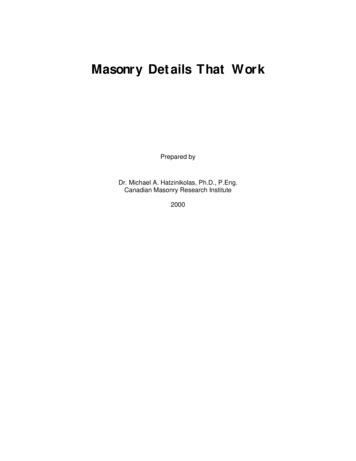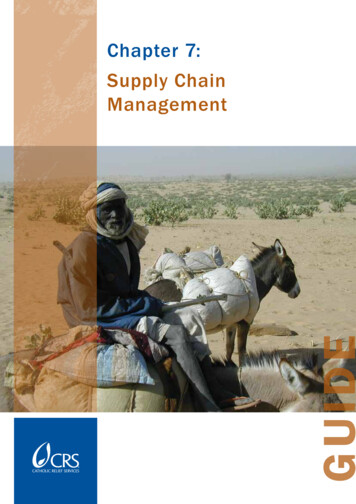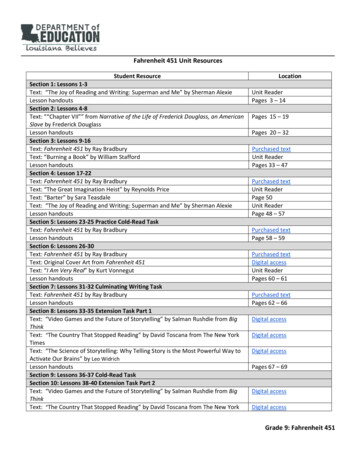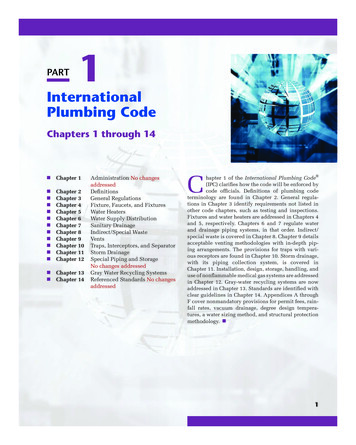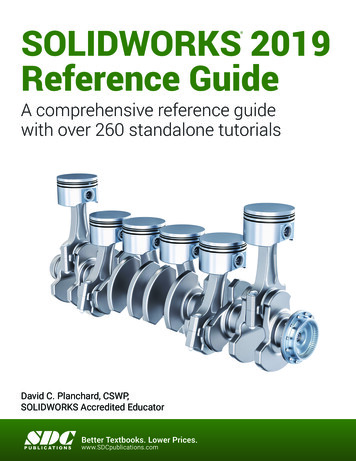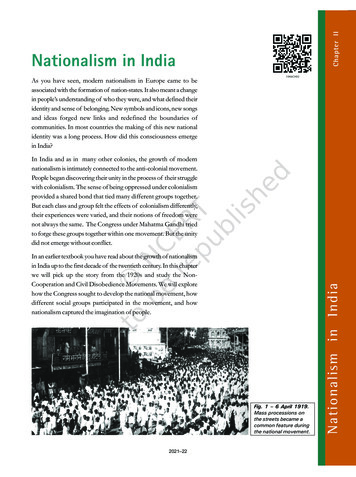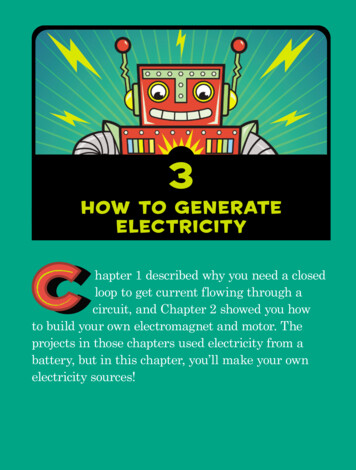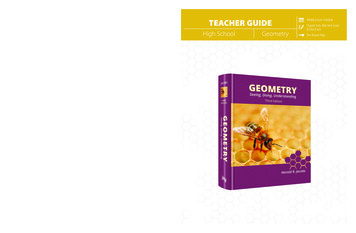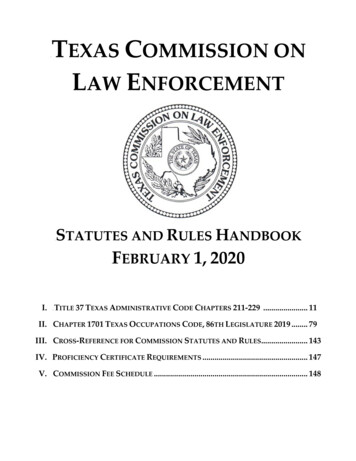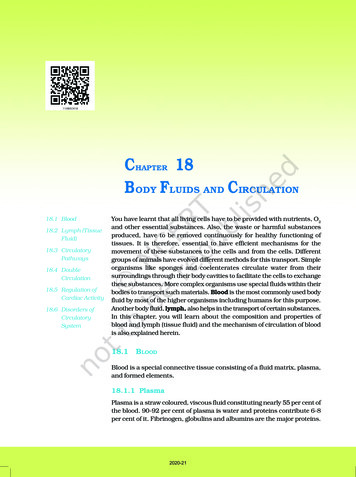
Transcription
278BIOLOGYC HAPTER 18B ODY FLUIDS AND C IRCULATION18.1 Blood18.2 Lymph (TissueFluid)18.3 CirculatoryPathways18.4 DoubleCirculation18.5 Regulation ofCardiac Activity18.6 Disorders ofCirculatorySystemYou have learnt that all living cells have to be provided with nutrients, O2and other essential substances. Also, the waste or harmful substancesproduced, have to be removed continuously for healthy functioning oftissues. It is therefore, essential to have efficient mechanisms for themovement of these substances to the cells and from the cells. Differentgroups of animals have evolved different methods for this transport. Simpleorganisms like sponges and coelenterates circulate water from theirsurroundings through their body cavities to facilitate the cells to exchangethese substances. More complex organisms use special fluids within theirbodies to transport such materials. Blood is the most commonly used bodyfluid by most of the higher organisms including humans for this purpose.Another body fluid, lymph, also helps in the transport of certain substances.In this chapter, you will learn about the composition and properties ofblood and lymph (tissue fluid) and the mechanism of circulation of bloodis also explained herein.18.1 BLOODBlood is a special connective tissue consisting of a fluid matrix, plasma,and formed elements.18.1.1 PlasmaPlasma is a straw coloured, viscous fluid constituting nearly 55 per cent ofthe blood. 90-92 per cent of plasma is water and proteins contribute 6-8per cent of it. Fibrinogen, globulins and albumins are the major proteins.2020-21
BODY FLUIDS AND CIRCULATION279Fibrinogens are needed for clotting or coagulation of blood. Globulinsprimarly are involved in defense mechanisms of the body and the albuminshelp in osmotic balance. Plasma also contains small amounts of mineralslike Na , Ca , Mg , HCO3–, Cl–, etc. Glucose, amino acids, lipids, etc., arealso present in the plasma as they are always in transit in the body. Factorsfor coagulation or clotting of blood are also present in the plasma in aninactive form. Plasma without the clotting factors is called serum.18.1.2 Formed ElementsErythrocytes, leucocytes and platelets are collectively called formedelements (Figure 18.1) and they constitute nearly 45 per cent of the blood.Erythrocytes or red blood cells (RBC) are the most abundant of allthe cells in blood. A healthy adult man has, on an average, 5 millions to5.5 millions of RBCs mm–3 of blood. RBCs are formed in the red bonemarrow in the adults. RBCs are devoid of nucleus in most of the mammalsand are biconcave in shape. They have a red coloured, iron containingcomplex protein called haemoglobin, hence the colour and name of thesecells. A healthy individual has 12-16 gms of haemoglobin in every100 ml of blood. These molecules play a significant role in transport ofrespiratory gases. RBCs have an average life span of 120 days after whichthey are destroyed in the spleen (graveyard of RBCs).Leucocytes are also known as white blood cells (WBC) as they arecolourless due to the lack of haemoglobin. They are nucleated and arerelatively lesser in number which averages 6000-8000 mm–3 of blood.Leucocytes are generally short lived. We have two main categories of WBCs– granulocytes and agranulocytes. Neutrophils, eosinophils and basophilsare different types of granulocytes, while lymphocytes and monocytesare the agranulocytes. Neutrophils are the most abundant cells (60-65per cent) of the total WBCs and basophils are the least (0.5-1 per cent)among them. Neutrophils and monocytes (6-8 per cent) are phagocyticcells which destroy foreign organisms entering the body. Basophils secretehistamine, serotonin, heparin, etc., and are involved in inflammatoryreactions. Eosinophils (2-3 per cent) resist infections and are alsoNeutrophilEosinophilRBCPlateletsBasophilT lymphocyteMonocyteB lymphocyteFigure 18.1 Diagrammatic representation of formed elements in blood2020-21
280BIOLOGYassociated with allergic reactions. Lymphocytes (20-25 per cent) are oftwo major types – ‘B’ and ‘T’ forms. Both B and T lymphocytes areresponsible for immune responses of the body.Platelets also called thrombocytes, are cell fragments produced frommegakaryocytes (special cells in the bone marrow). Blood normallycontains 1,500,00-3,500,00 platelets mm–3. Platelets can release a varietyof substances most of which are involved in the coagulation or clotting ofblood. A reduction in their number can lead to clotting disorders whichwill lead to excessive loss of blood from the body.18.1.3 Blood GroupsAs you know, blood of human beings differ in certain aspects though itappears to be similar. Various types of grouping of blood has been done.Two such groupings – the ABO and Rh – are widely used all over theworld.18.1.3.1 ABO groupingABO grouping is based on the presence or absence of two surface antigens(chemicals that can induce immune response) on the RBCs namely Aand B. Similarly, the plasma of different individuals contain two naturalantibodies (proteins produced in response to antigens). The distributionof antigens and antibodies in the four groups of blood, A, B, AB and Oare given in Table 18.1. You probably know that during blood transfusion,any blood cannot be used; the blood of a donor has to be carefully matchedwith the blood of a recipient before any blood transfusion to avoid severeproblems of clumping (destruction of RBC). The donor’s compatibility isalso shown in the Table 18.1.TABLE 18.1 Blood Groups and Donor CompatibilityBlood GroupAntigens onRBCsAntibodies Donor’s Groupin PlasmaAAanti-BA, OBBanti-AB, OABA, BnilAB, A, B, OOnilanti-A, BOFrom the above mentioned table it is evident that group ‘O’ blood canbe donated to persons with any other blood group and hence ‘O’ groupindividuals are called ‘universal donors’. Persons with ‘AB’ group canaccept blood from persons with AB as well as the other groups of blood.Therefore, such persons are called ‘universal recipients’.2020-21
BODY FLUIDS AND CIRCULATION18.1.3.2281Rh groupingAnother antigen, the Rh antigen similar to one present in Rhesus monkeys(hence Rh), is also observed on the surface of RBCs of majority (nearly 80per cent) of humans. Such individuals are called Rh positive (Rh ve)and those in whom this antigen is absent are called Rh negative (Rh-ve).An Rh-ve person, if exposed to Rh ve blood, will form specific antibodiesagainst the Rh antigens. Therefore, Rh group should also be matchedbefore transfusions. A special case of Rh incompatibility (mismatching)has been observed between the Rh-ve blood of a pregnant mother withRh ve blood of the foetus. Rh antigens of the foetus do not get exposed tothe Rh-ve blood of the mother in the first pregnancy as the two bloods arewell separated by the placenta. However, during the delivery of the firstchild, there is a possibility of exposure of the maternal blood to smallamounts of the Rh ve blood from the foetus. In such cases, the motherstarts preparing antibodies against Rh antigen in her blood. In case ofher subsequent pregnancies, the Rh antibodies from the mother (Rh-ve)can leak into the blood of the foetus (Rh ve) and destroy the foetal RBCs.This could be fatal to the foetus or could cause severe anaemia andjaundice to the baby. This condition is called erythroblastosis foetalis.This can be avoided by administering anti-Rh antibodies to the motherimmediately after the delivery of the first child.18.1.4 Coagulation of BloodYou know that when you cut your finger or hurt yourself, your wounddoes not continue to bleed for a long time; usually the blood stops flowingafter sometime. Do you know why? Blood exhibits coagulation or clottingin response to an injury or trauma. This is a mechanism to preventexcessive loss of blood from the body. You would have observed a darkreddish brown scum formed at the site of a cut or an injury over a periodof time. It is a clot or coagulam formed mainly of a network of threadscalled fibrins in which dead and damaged formed elements of blood aretrapped. Fibrins are formed by the conversion of inactive fibrinogens inthe plasma by the enzyme thrombin. Thrombins, in turn are formed fromanother inactive substance present in the plasma called prothrombin. Anenzyme complex, thrombokinase, is required for the above reaction. Thiscomplex is formed by a series of linked enzymic reactions (cascadeprocess) involving a number of factors present in the plasma in an inactivestate. An injury or a trauma stimulates the platelets in the blood to releasecertain factors which activate the mechanism of coagulation. Certainfactors released by the tissues at the site of injury also can initiatecoagulation. Calcium ions play a very important role in clotting.2020-21
282BIOLOGY18.2 LYMPH (TISSUE FLUID)As the blood passes through the capillaries in tissues, some water alongwith many small water soluble substances move out into the spacesbetween the cells of tissues leaving the larger proteins and most of theformed elements in the blood vessels. This fluid released out is called theinterstitial fluid or tissue fluid. It has the same mineral distribution asthat in plasma. Exchange of nutrients, gases, etc., between the blood andthe cells always occur through this fluid. An elaborate network of vesselscalled the lymphatic system collects this fluid and drains it back to themajor veins. The fluid present in the lymphatic system is called the lymph.Lymph is a colourless fluid containing specialised lymphocytes whichare responsible for the immune responses of the body. Lymph is also animportant carrier for nutrients, hormones, etc. Fats are absorbed throughlymph in the lacteals present in the intestinal villi.18.3 CIRCULATORY PATHWAYSThe circulatory patterns are of two types – open or closed. Opencirculatory system is present in arthropods and molluscs in which bloodpumped by the heart passes through large vessels into open spaces orbody cavities called sinuses. Annelids and chordates have a closedcirculatory system in which the blood pumped by the heart is alwayscirculated through a closed network of blood vessels. This pattern isconsidered to be more advantageous as the flow of fluid can be moreprecisely regulated.All vertebrates possess a muscular chambered heart. Fishes have a2-chambered heart with an atrium and a ventricle. Amphibians and thereptiles (except crocodiles) have a 3-chambered heart with two atria and asingle ventricle, whereas crocodiles, birds and mammals possess a4-chambered heart with two atria and two ventricles. In fishes the heartpumps out deoxygenated blood which is oxygenated by the gills andsupplied to the body parts from where deoxygenated blood is returned tothe heart (single circulation). In amphibians and reptiles, the left atriumreceives oxygenated blood from the gills/lungs/skin and the right atriumgets the deoxygenated blood from other body parts. However, they get mixedup in the single ventricle which pumps out mixed blood (incomplete doublecirculation). In birds and mammals, oxygenated and deoxygenated bloodreceived by the left and right atria respectively passes on to the ventricles ofthe same sides. The ventricles pump it out without any mixing up, i.e., twoseparate circulatory pathways are present in these organisms, hence, theseanimals have double circulation. Let us study the human circulatorysystem.2020-21
BODY FLUIDS AND CIRCULATION28318.3.1 Human Circulatory SystemHuman circulatory system, also called the blood vascular system consistsof a muscular chambered heart, a network of closed branching bloodvessels and blood, the fluid which is circulated.Heart, the mesodermally derived organ, is situated in the thoraciccavity, in between the two lungs, slightly tilted to the left. It has the size ofa clenched fist. It is protected by a double walled membranous bag,pericardium, enclosing the pericardial fluid. Our heart has fourchambers, two relatively small upper chambers called atria and two largerlower chambers called ventricles. A thin, muscular wall called the interatrial septum separates the right and the left atria, whereas a thick-walled,the inter-ventricular septum, separates the left and the right ventricles(Figure 18.2). The atrium and the ventricle of the same side are alsoseparated by a thick fibrous tissue called the atrio-ventricular septum.However, each of these septa are provided with an opening through whichthe two chambers of the same side are connected. The opening betweenthe right atrium and the right ventricle is guarded by a valve formed ofthree muscular flaps or cusps, the tricuspid valve, whereas a bicuspidor mitral valve guards the opening between the left atrium and the leftventricle. The openings of the right and the left ventricles into theFigure 18.2 Section of a human heart2020-21
284BIOLOGYpulmonary artery and the aorta respectively are provided with thesemilunar valves. The valves in the heart allows the flow of blood only inone direction, i.e., from the atria to the ventricles and from the ventriclesto the pulmonary artery or aorta. These valves prevent any backwardflow.The entire heart is made of cardiac muscles. The walls of ventriclesare much thicker than that of the atria. A specialised cardiac musculaturecalled the nodal tissue is also distributed in the heart (Figure 18.2). Apatch of this tissue is present in the right upper corner of the right atriumcalled the sino-atrial node (SAN). Another mass of this tissue is seen inthe lower left corner of the right atrium close to the atrio-ventricular septumcalled the atrio-ventricular node (AVN). A bundle of nodal fibres, atrioventricular bundle (AV bundle) continues from the AVN which passesthrough the atrio-ventricular septa to emerge on the top of the interventricular septum and immediately divides into a right and left bundle.These branches give rise to minute fibres throughout the ventricularmusculature of the respective sides and are called purkinje fibres. Thenodal musculature has the ability to generate action potentials withoutany external stimuli, i.e., it is autoexcitable. However, the number of actionpotentials that could be generated in a minute vary at different parts ofthe nodal system. The SAN can generate the maximum number of actionpotentials, i.e., 70-75 min–1, and is responsible for initiating andmaintaining the rhythmic contractile activity of the heart. Therefore, it iscalled the pacemaker. Our heart normally beats 70-75 times in a minute(average 72 beats min–1).18.3.2 Cardiac CycleHow does the heart function? Let us take a look. To begin with, all thefour chambers of heart are in a relaxed state, i.e., they are in jointdiastole. As the tricuspid and bicuspid valves are open, blood from thepulmonary veins and vena cava flows into the left and the right ventriclerespectively through the left and right atria. The semilunar valves areclosed at this stage. The SAN now generates an action potential whichstimulates both the atria to undergo a simultaneous contraction – theatrial systole. This increases the flow of blood into the ventricles by about30 per cent. The action potential is conducted to the ventricular side bythe AVN and AV bundle from where the bundle of His transmits it throughthe entire ventricular musculature. This causes the ventricular musclesto contract, (ventricular systole), the atria undergoes relaxation(diastole), coinciding with the ventricular systole. Ventricular systoleincreases the ventricular pressure causing the closure of tricuspid and2020-21
BODY FLUIDS AND CIRCULATION285bicuspid valves due to attempted backflow of blood into the atria. Asthe ventricular pressure increases further, the semilunar valves guardingthe pulmonary artery (right side) and the aorta (left side) are forced open,allowing the blood in the ventricles to flow through these vessels intothe circulatory pathways. The ventricles now relax (ventricular diastole)and the ventricular pressure falls causing the closure of semilunar valveswhich prevents the backflow of blood into the ventricles. As theventricular pressure declines further, the tricuspid and bicuspid valvesare pushed open by the pressure in the atria exerted by the blood whichwas being emptied into them by the veins. The blood now once againmoves freely to the ventricles. The ventricles and atria are now again ina relaxed (joint diastole) state, as earlier. Soon the SAN generates a newaction potential and the events described above are repeated in thatsequence and the process continues.This sequential event in the heart which is cyclically repeated is calledthe cardiac cycle and it consists of systole and diastole of both the atriaand ventricles. As mentioned earlier, the heart beats 72 times per minute,i.e., that many cardiac cycles are performed per minute. From this it couldbe deduced that the duration of a cardiac cycle is 0.8 seconds. During acardiac cycle, each ventricle pumps out approximately 70 mL of bloodwhich is called the stroke volume. The stroke volume multiplied by theheart rate (no. of beats per min.) gives the cardiac output. Therefore, thecardiac output can be defined as the volume of blood pumped out by eachventricle per minute and averages 5000 mL or 5 litres in a healthy individual.The body has the ability to alter the stroke volume as well as the heart rateand thereby the cardiac output. For example, the cardiac output of anathlete will be much higher than that of an ordinary man.During each cardiac cycle two prominent sounds are produced whichcan be easily heard through a stethoscope. The first heart sound (lub) isassociated with the closure of the tricuspid and bicuspid valves whereasthe second heart sound (dub) is associated with the closure of thesemilunar valves. These sounds are of clinical diagnostic significance.18.3.3 Electrocardiograph (ECG)You are probably familiar with this scene from a typical hospital televisionshow: A patient is hooked up to a monitoring machine that shows voltagetraces on a screen and makes the sound “. pip. pip. pip.peeeeeeeeeeeeeeeeeeeeee” as the patient goes into cardiac arrest. This typeof machine (electro-cardiograph) is used to obtain an electrocardiogram(ECG). ECG is a graphical representation of the electrical activity of theheart during a cardiac cycle. To obtain a standard ECG (as shown in the2020-21
286BIOLOGYFigure 18.3), a patient is connected to themachine with three electrical leads (one to eachwrist and to the left ankle) that continuouslymonitor the heart activity. For a detailedevaluation of the heart’s function, multipleleads are attached to the chest region. Here,we will talk only about a standard ECG.Each peak in the ECG is identified with aletterfrom P to T that corresponds to a specificFigure 18.3 Diagrammatic presentation of aelectrical activity of the heart.standard ECGThe P-wave represents the electricalexcitation (or depolarisation) of the atria,which leads to the contraction of both the atria.The QRS complex represents the depolarisation of the ventricles,which initiates the ventricular contraction. The contraction starts shortlyafter Q and marks the beginning of the systole.The T-wave represents the return of the ventricles from excited to normalstate (repolarisation). The end of the T-wave marks the end of systole.Obviously, by counting the number of QRS complexes that occur in agiven time period, one can determine the heart beat rate of an individual.Since the ECGs obtained from different individuals have roughly the sameshape for a given lead configuration, any deviation from this shape indicatesa possible abnormality or disease. Hence, it is of a great clinical significance.18.4 DOUBLE CIRCULATIONThe blood flows strictly by a fixed route through Blood Vessels—thearteries and veins. Basically, each artery and vein consists of three layers:an inner lining of squamous endothelium, the tunica intima, a middlelayer of smooth muscle and elastic fibres, the tunica media, and anexternal layer of fibrous connective tissue with collagen fibres, the tunicaexterna. The tunica media is comparatively thin in the veins (Figure18.4).As mentioned earlier, the blood pumped by the right ventricle entersthe pulmonary artery, whereas the left ventricle pumps blood into theaorta. The deoxygenated blood pumped into the pulmonary artery ispassed on to the lungs from where the oxygenated blood is carried bythe pulmonary veins into the left atrium. This pathway constitutes thepulmonary circulation. The oxygenated blood entering the aorta iscarried by a network of arteries, arterioles and capillaries to the tissuesfrom where the deoxygenated blood is collected by a system of venules,veins and vena cava and emptied into the right atrium. This is thesystemic circulation (Figure 18.4). The systemic circulation providesnutrients, O2 and other essential substances to the tissues and takesCO2 and other harmful substances away for elimination. A uniquevascular connection exists between the digestive tract and liver called2020-21
BODY FLUIDS AND CIRCULATION287hepatic portal system. The hepatic portal vein carries blood from intestineto the liver before it is delivered to the systemic circulation. A specialcoronary system of blood vessels is present in our body exclusively forthe circulation of blood to and from the cardiac musculature.Figure 18.4 Schematic plan of blood circulation in human18.5 REGULATIONOFCARDIAC ACTIVITYNormal activities of the heart are regulated intrinsically, i.e., auto regulatedby specialised muscles (nodal tissue), hence the heart is called myogenic.A special neural centre in the medulla oblangata can moderate the cardiacfunction through autonomic nervous system (ANS). Neural signals throughthe sympathetic nerves (part of ANS) can increase the rate of heart beat,the strength of ventricular contraction and thereby the cardiac output.On the other hand, parasympathetic neural signals (another componentof ANS) decrease the rate of heart beat, speed of conduction of actionpotential and thereby the cardiac output. Adrenal medullary hormonescan also increase the cardiac output.18.6 DISORDERS OF CIRCULATORY SYSTEMHigh Blood Pressure (Hypertension): Hypertension is the term for bloodpressure that is higher than normal (120/80). In this measurement 120mm Hg (millimetres of mercury pressure) is the systolic, or pumping,pressure and 80 mm Hg is the diastolic, or resting, pressure. If repeatedchecks of blood pressure of an individual is 140/90 (140 over 90) or2020-21
288BIOLOGYhigher, it shows hypertension. High blood pressure leads to heart diseasesand also affects vital organs like brain and kidney.Coronary Artery Disease (CAD): Coronary Artery Disease, often referredto as atherosclerosis, affects the vessels that supply blood to the heartmuscle. It is caused by deposits of calcium, fat, cholesterol and fibroustissues, which makes the lumen of arteries narrower.Angina: It is also called ‘angina pectoris’. A symptom of acute chest painappears when no enough oxygen is reaching the heart muscle. Anginacan occur in men and women of any age but it is more common amongthe middle-aged and elderly. It occurs due to conditions that affect theblood flow.Heart Failure: Heart failure means the state of heart when it is not pumpingblood effectively enough to meet the needs of the body. It is sometimescalled congestive heart failure because congestion of the lungs is one ofthe main symptoms of this disease. Heart failure is not the same as cardiacarrest (when the heart stops beating) or a heart attack (when the heartmuscle is suddenly damaged by an inadequate blood supply).SUMMARYVertebrates circulate blood, a fluid connective tissue, in their body, to transport essentialsubstances to the cells and to carry waste substances from there. Another fluid, lymph(tissue fluid) is also used for the transport of certain substances.Blood comprises of a fluid matrix, plasma and formed elements. Red blood cells (RBCs,erythrocytes), white blood cells (WBCs, leucocytes) and platelets (thrombocytes) constitutethe formed elements. Blood of humans are grouped into A, B, AB and O systems basedon the presence or absence of two surface antigens, A, B on the RBCs. Another bloodgrouping is also done based on the presence or absence of another antigen called Rhesusfactor (Rh) on the surface of RBCs. The spaces between cells in the tissues contain a fluidderived from blood called tissue fluid. This fluid called lymph is almost similar to bloodexcept for the protein content and the formed elements.All vertebrates and a few invertebrates have a closed circulatory system. Our circulatorysystem consists of a muscular pumping organ, heart, a network of vessels and a fluid, blood.Heart has two atria and two ventricles. Cardiac musculature is auto-excitable. Sino-atrial node(SAN) generates the maximum number of action protentials per minute (70-75/min) andtherefore, it sets the pace of the activities of the heart. Hence it is called the Pacemaker. Theaction potential causes the atria and then the ventricles to undergo contraction (systole) followedby their relaxation (diastole). The systole forces the blood to move from the atria to the ventriclesand to the pulmonary artery and the aorta. The cardiac cycle is formed by sequential events inthe heart which is cyclically repeated and is called the cardiac cycle. A healthy person shows 72such cycles per minute. About 70 mL of blood is pumped out by each ventricle during acardiac cycle and it is called the stroke or beat volume. Volume of blood pumped out by eachventricle of heart per minute is called the cardiac output and it is equal to the product of strokevolume and heart rate (approx 5 litres). The electrical activity of the heart can be recorded from2020-21
BODY FLUIDS AND CIRCULATION289the body surface by using electrocardiograph and the recording is calledelectrocardiogram (ECG) which is of clinical importance.We have a complete double circulation, i.e., two circulatory pathways, namely,pulmonary and systemic are present. The pulmonary circulation starts by thepumping of deoxygenated blood by the right ventricle which is carried to the lungswhere it is oxygenated and returned to the left atrium. The systemic circulationstarts with the pumping of oxygenated blood by the left ventricle to the aortawhich is carried to all the body tissues and the deoxygenated blood from there iscollected by the veins and returned to the right atrium. Though the heart isautoexcitable, its functions can be moderated by neural and hormonal mechanisms.EXERCISES1. Name the components of the formed elements in the blood and mention onemajor function of each of them.2. What is the importance of plasma proteins?3. Match Column I with Column II :Column IColumn II(a) Eosinophils(i) Coagulation(b) RBC(ii) Universal Recipient(c) AB Group(iii) Resist Infections(d) Platelets(iv) Contraction of Heart(e) Systole(v) Gas transport4. Why do we consider blood as a connective tissue?5. What is the difference between lymph and blood?6. What is meant by double circulation? What is its significance?7. Write the differences between :(a) Blood and Lymph(b) Open and Closed system of circulation(c) Systole and Diastole(d) P-wave and T-wave8. Describe the evolutionary change in the pattern of heart among the vertebrates.9. Why do we call our heart myogenic?10. Sino-atrial node is called the pacemaker of our heart. Why?11. What is the significance of atrio-ventricular node and atrio-ventricular bundlein the functioning of heart?12. Define a cardiac cycle and the cardiac output.13. Explain heart sounds.14. Draw a standard ECG and explain the different segments in it.2020-21
inactive form. Plasma without the clotting factors is called serum. 18.1.2 Formed Elements Erythrocytes, leucocytes and platelets are collectively called formed elements (Figure 18.1) and they constitute nearly 45 per cent of the blood. Erythrocytes or red blood cel
